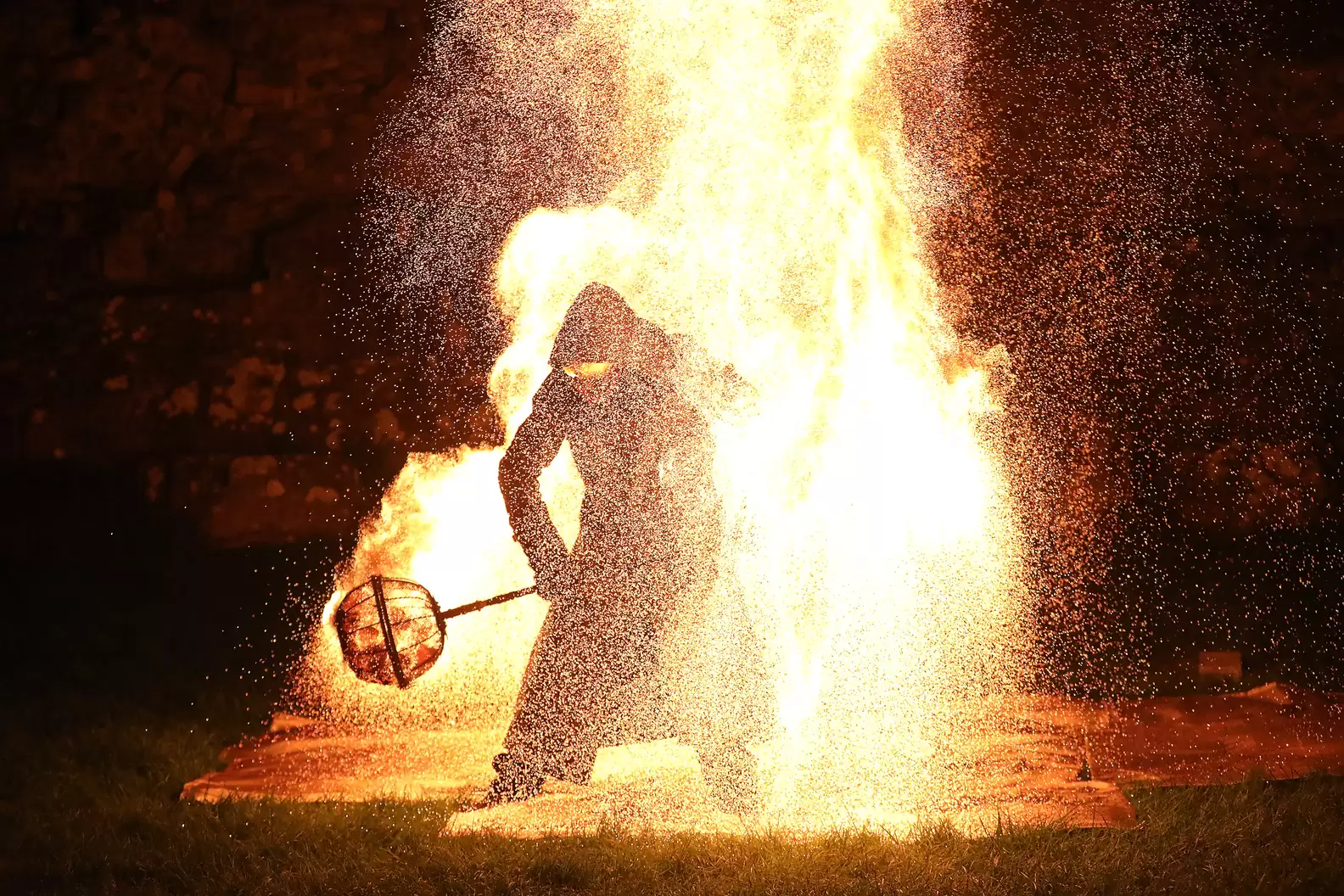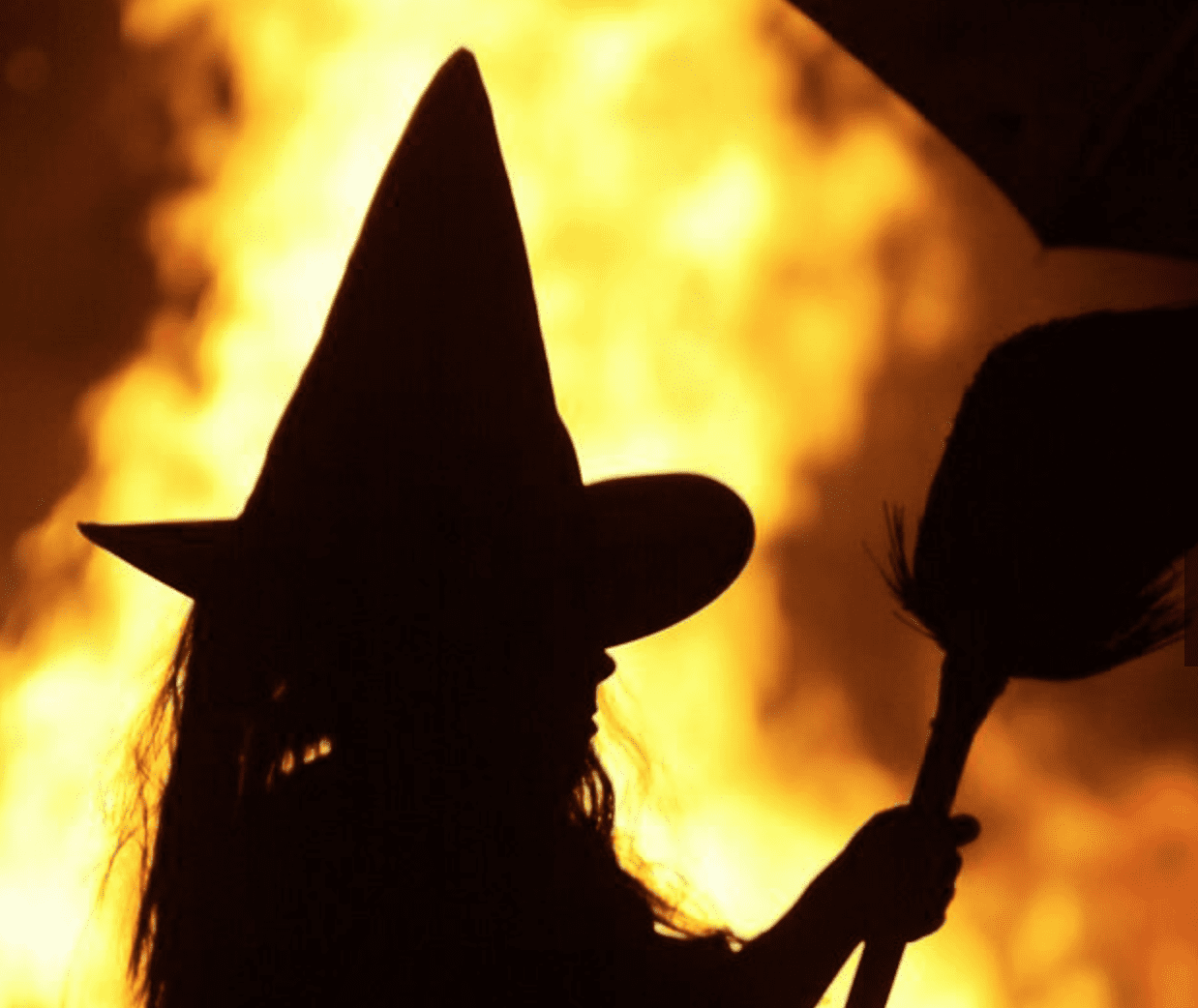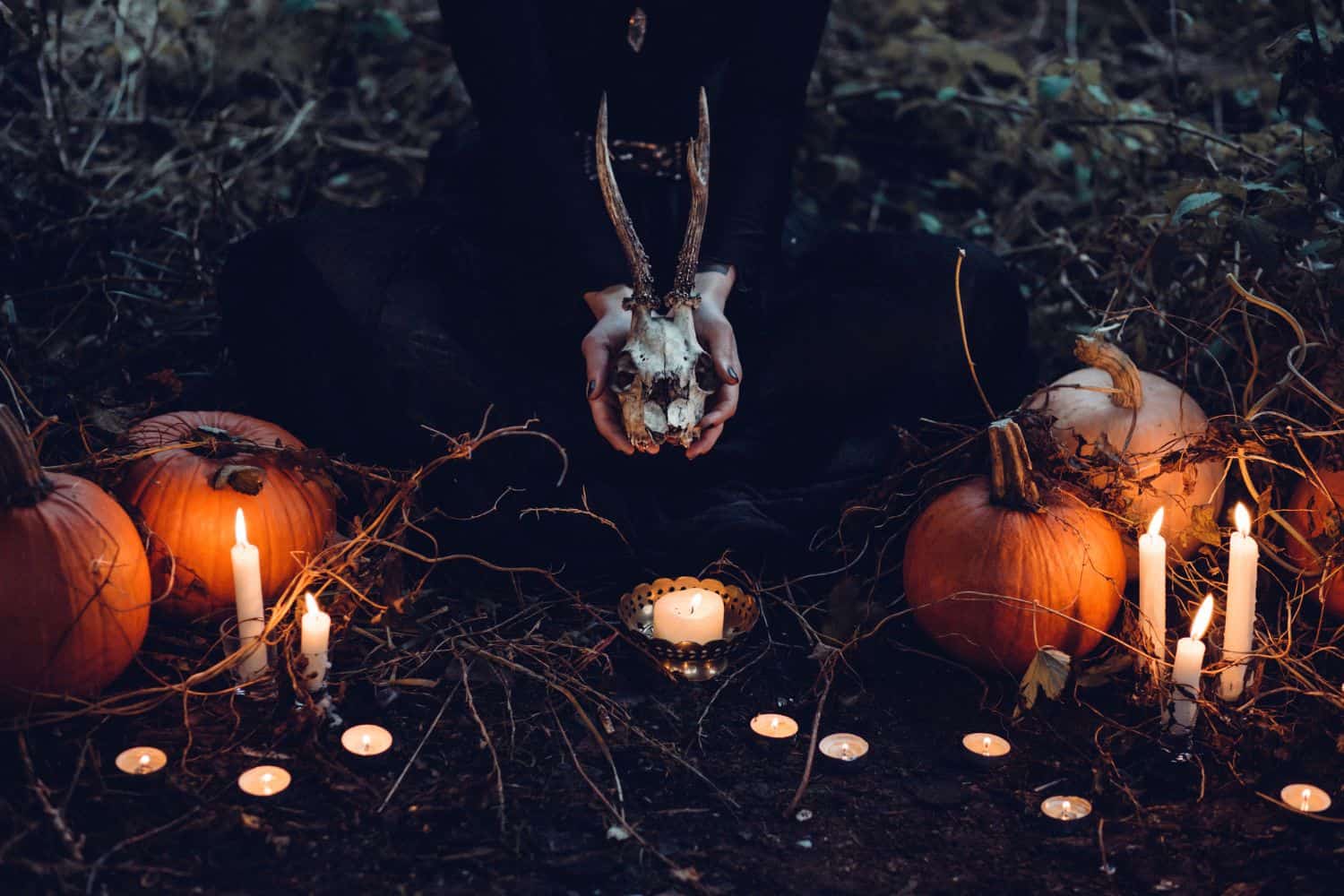
The Samhain meaning ain’t no hollow Halloween hoot—it’s a Celtic howl from the heart of Ireland’s ancient earth, a fire festival where the veil between worlds thins to a whisper, and the dead dance with the living under a blood-moon’s glare.
Pronounced “SOW-in” in Gaeilge, the Samhain meaning in English is November, but its soul is the Celtic New Year, a midnight moment on October 31 when spirits slip through the cracks, ancestors whisper wisdom, and the living light bonfires to ward off the wicked.
Rooted in Ireland’s misty moors, Samhain meaning Celtic is a primal pulse—death and rebirth, harvest’s end, winter’s wrath—a festival older than the ogham stones, fiercer than the Fomorians’ fury.
This ain’t no plastic-pumpkin party. Samhain traditions—bonfires blazing, turnip lanterns leering, feasts for the fallen—bind the living to the lost, a ritual roar that echoes from Tara’s hills to the Gaeltacht’s glens.
Who celebrates Samhain? Pagans, Wiccans, Druids, and Ireland’s culture keepers, from Cork’s craic to Donegal’s dirge, plus global souls drawn to its mystic marrow—some 50,000 in Ireland alone, per cultural surveys, and millions more in the Celtic diaspora.
Samhain mythology weaves gods like the Dagda, the Morrígan’s raven-winged wrath, and whispers of a Samhain demon, a fiction spun by later lore but rooted in fear of the Otherworld’s open door.
And Samhain Halloween? They’re kin, not twins—Halloween’s candy-coated shell masks Samhain’s raw soul, a Christian cloak on a Celtic core.
In this 5000-word tempest—forged in fiery prose and snarling from every stanza, we’ll haul you into Ireland’s ancient abyss—we’ll unravel the Samhain meaning.
From Samhain symbols like the bonfire and apple to FAQs on gods, demons, and Gaeilge greetings, we’ll bridge the knowledge gap with a banshee’s belt.
Ever wondered why we light candles on Samhain or what the Bible mutters about it? Or how to say “Happy Samhain” in Irish? Strap in, mo chara, for a journey through the veil, where Samhain traditions burn brighter than the euro’s gleam. Let’s leap into the lilt of the dead. Explore more on Secret Ireland’s Halloween lore.
Ever lit a candle to ward off spirits or wondered if Samhain’s a demon’s dance? Dive into the Celtic cauldron—we’ll decode the gods, the greetings, and the ghosts.
The Celtic Core: What Does Samhain Symbolize?
What does Samhain symbolize? It’s the Celtic soul’s snarl at the cycle’s edge, a festival marking the death of summer’s light and the birth of winter’s dark, a pivot where the harvest’s hoard bows to the frost’s fist.
The Samhain meaning Celtic is transition—life to death, light to shadow, the veil between worlds so thin spirits slip through like mist over the Boyne. Celebrated October 31 to November 1, it’s the Celtic New Year, a time to honor ancestors, appease the Aos Sí (fairy folk), and brace for winter’s bite.
Bonfires, a key Samhain symbol, blaze to banish malevolent spirits; apples, another symbol, nod to rebirth, per archaeological finds at Tara’s ancient mounds. The Dagda, Celtic god of plenty, looms large, his club carving life and death, while the Morrígan’s raven caws chaos.
Samhain traditions—feasts with a seat for the dead, turnip lanterns to light the lost, divination by firelight—bind the living to the Otherworld.
Who celebrates Samhain? Ireland’s pagans (some 2,000, per 2022 Census), global Wiccans (est. 1 million), and culture vultures from Dublin to Denver, drawn to its primal pulse. T
he Samhain meaning in English? November, from Gaeilge’s “Samhain,” but its essence is eternal: a reckoning with mortality, a revel in rebirth. Samhain’s a Celtic crucible, its Samhain mythology a map of the mystic, its symbols a shield against the shadow’s shiver.
But the roots run deep: 2,500-year-old bog bodies, like Old Croghan Man, suggest ritual sacrifices at Samhain, per National Museum of Ireland. The Celts saw time as a wheel, Samhain the spoke where worlds wheel together, spirits and sidhe (fairies) mingling with mortals.
The Samhain Halloween link? Halloween’s a Christian gloss, All Hallows’ Eve papering over Samhain’s pagan fire, but the bones remain Celtic. Samhain symbols—fire, apples, bones—still burn in Ireland’s soul, from Galway’s Gaeltacht to global pagan gatherings.
Samhain in Irish: The Gaeilge Gospel
What is Samhain in Irish? It’s “Samhain” (SOW-in), the Gaeilge word for November, but more—a fire festival, the Celtic New Year, a night when the veil thins and the dead drift close.
The Samhain meaning in English is clinical—November—but in Gaeilge language, it’s a primal pulse, rooted in Ireland’s Celtic marrow.
Samhain traditions in Gaeilge? “Oíche Shamhna” (EE-ha HOW-na), the night of Samhain, sees bonfires lit, turnips carved into jack-o’-lanterns, and barmbrack baked with charms to divine the future. Who celebrates Samhain? Ireland’s 71,968 daily Gaeilge speakers (2022 Census), pagans, and cultural keepers, chanting “Beannachtaí Oíche Shamhna” (Happy Samhain) in Gaeltachts from Dingle to Donegal.
How do you say happy Samhain in Irish? “Beannachtaí Oíche Shamhna” (BAN-ukh-tee EE-ha HOW-na), a blessing for the night’s mystic mischief.
Samhain in Gaeilge is the soul’s snarl, a Celtic cry that’s outlasted empires, its Samhain mythology woven with gods like the Dagda and the Morrígan, its Samhain symbols—fire, apples, bones—etched in Ireland’s earth.
The Samhain Halloween blur? Oíche Shamhna birthed Halloween, but the Christian cloak can’t hide the Celtic core. Secret Ireland’s Halloween insights dig deeper into this Gaeilge glow.
Samhain vs. Halloween: Kin or Stranger?

Is Samhain the same as Halloween? Nay, they’re kin, not twins—a Celtic root grafted with Christian rind. Samhain Halloween share October 31, but Samhain’s the elder, a 2,500-year-old Celtic fire festival where the veil thins, ancestors are honored, and bonfires blaze to banish spirits.
Halloween, or All Hallows’ Eve, is the Christian remix, tied to All Saints’ Day (November 1), papering pagan rites with prayers.
The Samhain meaning Celtic is death’s dance and rebirth’s roar; Halloween’s pumpkins and candy are a sugary shell, per History.com’s Halloween origins. Samhain traditions—turnip lanterns, feasts for the dead—morphed into Halloween’s jack-o’-lanterns and trick-or-treating.
Who celebrates Samhain? Pagans, Wiccans, Druids, and Ireland’s cultural keepers—some 50,000 in Ireland, millions globally—while Halloween’s a global bash, 70% of Americans partaking, per Statista.
Samhain Halloween share roots, but Samhain’s the raw soul, its Samhain symbols—bonfires, apples—older than Christianity’s cross.
The Samhain demon myth? A later fiction, not Celtic fact, but the fear of spirits lingers in both. Samhain’s no Halloween clone—it’s the fire beneath the candy’s gloss.
The Gods of Samhain: Myth or Monster?

Who is the god of Samhain? No single deity dons the crown, but the Dagda, Celtic god of plenty, looms large, his club carving life and death, his cauldron feeding the fallen, per Samhain mythology.
The Morrígan, war goddess with raven wings, stalks the shadows, her prophecies pulsing on October 31’s thin veil. Samhain meaning Celtic ties these gods to the festival’s core—transition, rebirth, the Otherworld’s open door. What kind of demon is Samhain?
No demon at all—Samhain’s a festival, not a fiend, though Christian lore spun tales of a Samhain demon to demonize pagan rites, per medieval texts. The Celts feared no devil, only mischievous Aos Sí, appeased with offerings.
Samhain mythology is god-rich, not demon-driven, with the Dagda’s bounty and the Morrígan’s menace shaping the night. Who celebrates Samhain?
Those honoring these deities—pagans, Druids, Wiccans—light bonfires to echo the gods’ glow, a Samhain tradition older than Tara’s mounds. The Samhain demon? A Christian smear, not a Celtic spectre, but the fear of the Otherworld fuels the festival’s fire.
Samhain and Scripture: The Bible’s Take
What does the Bible say about Samhain? Not a whisper—Samhain’s a Celtic pagan festival, predating Christianity by centuries, absent from biblical texts.
The Samhain meaning Celtic—a veil-thinning, ancestor-honoring rite—clashed with early Christian dogma, which branded it idolatry. Deuteronomy 18:10-12 warns against divination, a Samhain tradition like scrying by firelight, but Samhain itself? No mention.
Is Halloween part of Christianity? Halloween, as All Hallows’ Eve, ties to All Saints’ Day (November 1), a Christian feast, but its Samhain Halloween roots are pagan, per Britannica’s Halloween history. The Church co-opted Samhain’s date, not its spirit.
The Bible’s silent on Samhain, but its pagan pulse—bonfires, spirit offerings—spooked early Christians, who cloaked it in Halloween’s holy garb.
Who celebrates Samhain? Pagans and cultural keepers, not Christians, though some blend both, lighting candles for saints and spirits alike. The Samhain meaning in English—November—hides its heathen heart, a Celtic cry that outshines scripture’s shade.
Candles and the Veil: Why We Light the Flame
Why do we light candles on Samhain? To pierce the dark and guide the dead, a Samhain tradition rooted in Celtic fire rites.
As the veil thins on October 31, candles—Samhain symbols of light and protection—beckon ancestors and banish malevolent spirits, per archaeological evidence of Iron Age fire festivals.
In Ireland’s Gaeltachts, households light candles in windows, a beacon for the lost, while bonfires blaze on hills, echoing the Dagda’s warmth. Who celebrates Samhain? Pagans, Wiccans, and Ireland’s 50,000 cultural keepers, their flames a snarl against winter’s wrath.
Candles on Samhain aren’t just glow—they’re a Celtic vow, a Samhain mythology of guiding the good and guarding against the grim. The Samhain Halloween link? Halloween’s jack-o’-lanterns evolved from Samhain’s turnip lanterns, candles within warding off the Aos Sí. Light a candle, mo chara, and join the ancient dance. Secret Ireland’s Halloween rites illuminate more.
The Spiritual Pulse: October 31’s Mystic Meaning
What is the spiritual meaning of October 31? It’s Samhain’s soul, the Samhain meaning Celtic—a night when the veil between worlds thins, spirits roam, and the Celtic New Year dawns.
It’s rebirth through death, honoring ancestors with feasts, divining the future by firelight, and bracing for winter’s bite. Samhain symbols—bonfires, apples, bones—embody this spiritual pivot, a moment to reflect, release, and renew, per pagan practitioners.
Who celebrates Samhain? Ireland’s pagans, global Wiccans, and spiritual seekers—some 2 million worldwide—embrace its mystic marrow, from Tara’s mounds to Salem’s circles.
October 31’s Samhain meaning is a Celtic crucible, not Halloween’s candy-coated caper. The Samhain mythology of the Dagda and Morrígan pulses through, spirits and sidhe mingling with mortals. The Samhain Halloween blur? Halloween’s Christian cloak can’t hide Samhain’s spiritual snarl, a fire-lit vow to face the dark.
Three Facts to Know: The Essence of Samhain
What are three facts about Samhain? Here’s the triad, etched in Celtic stone:
- Celtic New Year: Samhain, October 31-November 1, marks the Celtic New Year, the Samhain meaning Celtic a pivot from summer’s end to winter’s start, the veil thinning for spirits to slip through, per Iron Age records.
- Bonfire Rites: Samhain traditions include bonfires to ward off evil spirits and honor ancestors, a practice echoed in Ireland’s Gaeltachts and global pagan gatherings, with 50,000 Irish celebrants.
- Halloween’s Root: The Samhain Halloween link is deep—Halloween’s All Hallows’ Eve co-opted Samhain’s date, turning turnip lanterns into pumpkins, but the Celtic core remains, per National Museum of Ireland.
What is the essence of Samhain? It’s the Celtic heart’s howl—death’s embrace, rebirth’s roar, the veil’s whisper where ancestors and Aos Sí dance. Samhain’s facts fuel its fire, a Samhain meaning in English that transcends November’s name.
Samhain’s English Name and Global Echo
What is the English name for Samhain? November, plain as peat, from the Gaeilge “Samhain,” but its Samhain meaning in English hides the festival’s fire—October 31’s Celtic New Year, a veil-thinning, spirit-summoning night. Samhain traditions—bonfires, turnip lanterns, barmbrack divination—carry its Celtic core, while who celebrates Samhain spans Ireland’s 2,000 pagans to global Wiccans, per cultural counts. The Samhain Halloween link? Halloween’s a Christian veneer, but Samhain’s the raw root, its Samhain symbols burning bright in Ireland’s soul.
FAQs: Unraveling the Samhain Saga
@irishdaily HAPPY HALLOWEEN 👻 everyone!!! 🎃💀👻 Did you know? Halloween was invented in Ireland. The roots of Halloween can be traced back 2,000 years to the Celtic Samhain festival. #Samhain 🎃 #happyhalloween . 📸👉 @StuartMackey(Taylor’s Version) 👏👻👏 #irishdaily #tiktokoftheday #ireland #samhain #travelireland #discoverireland #Halloween #spookyseason #Halloween2022 #irishdaily #fyp #tiktokireland #medieval
What does Samhain symbolize?
Samhain symbolizes the Celtic New Year, the Samhain meaning Celtic a pivot from summer’s end to winter’s start, where the veil thins, ancestors are honored, and spirits roam. Samhain symbols—bonfires, apples, bones—ward off evil and herald rebirth, per Celtic lore. Who celebrates Samhain? Pagans, Wiccans, and Ireland’s 50,000 cultural keepers, their rites a snarl against the dark. Secret Ireland’s Halloween lore digs deeper.
What is Samhain in Irish?
In Gaeilge, Samhain (SOW-in) means November, but its Samhain meaning in English is the Celtic New Year, October 31-November 1, when the veil thins. Samhain traditions—Oíche Shamhna’s bonfires, turnip lanterns—honor the dead. Who celebrates Samhain? Ireland’s 71,968 Gaeilge speakers and pagans, chanting “Beannachtaí Oíche Shamhna” in Gaeltachts.
Is Samhain the same as Halloween?
No, but they’re kin. Samhain Halloween share October 31, but Samhain’s a Celtic fire festival, the veil-thinning New Year, while Halloween’s All Hallows’ Eve, a Christian cloak. Samhain traditions—bonfires, turnips—became Halloween’s pumpkins, per History.com. Who celebrates Samhain? Pagans and Druids, not just trick-or-treaters.
Who is the god of Samhain?
No single god, but the Dagda, Celtic god of plenty, and the Morrígan, war goddess, rule Samhain mythology. Their presence marks the veil’s thinning, per Celtic lore. The Samhain demon? A Christian fiction, not a Celtic deity. Who celebrates Samhain? Pagans and Wiccans honor these gods with bonfires and feasts.
What does the Bible say about Samhain?
Nothing—Samhain’s a pre-Christian Celtic festival, absent from scripture. Deuteronomy 18:10-12 frowns on divination, a Samhain tradition, but Samhain itself? Silent. Is Halloween part of Christianity? Halloween ties to All Saints’ Day, but its Samhain Halloween roots are pagan, per Britannica.
Why do we light candles on Samhain?
Candles, a Samhain symbol, guide ancestors and banish evil spirits as the veil thins, a Samhain tradition rooted in Celtic fire rites. Who celebrates Samhain? Ireland’s pagans and global Wiccans light flames to echo the Dagda’s warmth, per archaeological finds. Secret Ireland explores more.
What is the English name for Samhain?
November, from Gaeilge’s “Samhain,” but its Samhain meaning in English is the Celtic New Year, October 31’s veil-thinning festival. Samhain traditions—bonfires, apples—carry its soul. Who celebrates Samhain? Pagans and cultural keepers, not just Halloween fans.
Is Halloween part of Christianity?
Halloween, as All Hallows’ Eve, ties to Christianity’s All Saints’ Day (November 1), but its Samhain Halloween roots are pagan, per History.com. Samhain meaning Celtic is the raw fire; Halloween’s the Christian gloss.
How do you say happy Samhain in Irish?
“Beannachtaí Oíche Shamhna” (BAN-ukh-tee EE-ha HOW-na), a Gaeilge blessing for Samhain night. Who celebrates Samhain? Ireland’s 71,968 Gaeilge speakers and pagans, their Samhain traditions a fiery snarl against the dark.
What is the spiritual meaning of October 31?
October 31’s Samhain meaning Celtic is the veil’s thinning, a Celtic New Year where ancestors are honored, spirits roam, and rebirth rises from death’s ashes. Samhain symbols—bonfires, apples—mark this mystic pivot, per pagan practice. Who celebrates Samhain? Pagans and Wiccans, their rites a spiritual roar.
What are three facts about Samhain?
1. Celtic New Year, October 31-November 1, when the veil thins, per Samhain mythology. 2. Samhain traditions include bonfires to ward off spirits, practiced by 50,000 in Ireland. 3. Samhain Halloween link—Halloween’s pumpkins evolved from Samhain’s turnips, per National Museum of Ireland.
What is the essence of Samhain?
The Samhain meaning is the Celtic heart’s howl—death’s embrace, rebirth’s roar, the veil’s whisper where ancestors and Aos Sí dance. Samhain symbols—fire, apples, bones—bind the living to the lost, a Samhain tradition for pagans and Ireland’s cultural keepers.
What kind of demon is Samhain?
No demon—Samhain’s a Celtic festival, not a fiend. The Samhain demon is a Christian fiction to smear pagan rites, per medieval texts. Samhain mythology honors gods like the Dagda, not devils. Who celebrates Samhain? Pagans and Wiccans, their bonfires banishing the myth.
The Last Lilt: Samhain’s Eternal Ember
So there ye stand, ye seekers of the shadow’s song, at the edge of the veil where the Samhain meaning burns bright—a Celtic New Year, a fire festival, a snarl against the dark.
The Samhain meaning in English—November—hides its heart, but the Samhain meaning Celtic is clear: death’s dance, rebirth’s roar, ancestors honored by bonfires and candles. Samhain Halloween? Kin, not clone—Halloween’s Christian candy coats Samhain’s pagan pulse.
Samhain traditions—turnips, apples, feasts—live in Ireland’s 50,000 celebrants, from Gaeltachts to global groves. The Samhain demon?
A myth, not might, but Samhain mythology—Dagda, Morrígan, Aos Sí—sings eternal. Samhain symbols light the way, a Celtic cry worth more than gold. Sláinte to the veil’s vigil, mo chara—may Samhain’s ember glow forever. Dive deeper at Secret Ireland.



